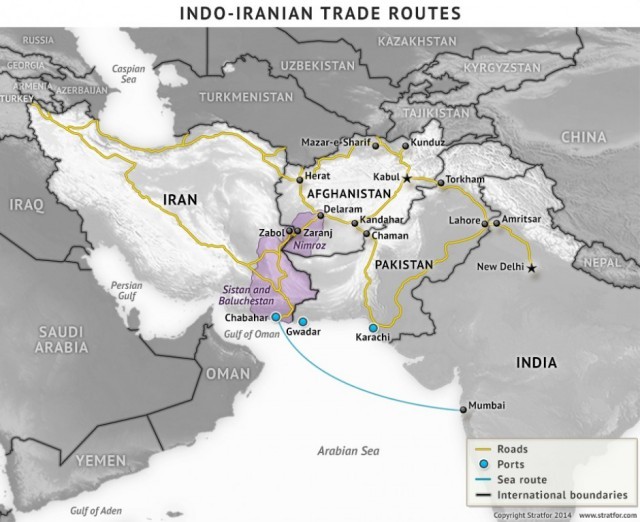NEW DELHI (TCA) — On December 3, Iran’s President Hassan Rouhani inaugurated the first phase of the Chabahar port development project on the Gulf of Oman, with the participation of senior Afghan and Indian ministers, including the Indian Minister for External Affairs Mrs. Sushma Swaraj.
Iranian media quoted President Rouhani as saying that the port “will enhance trade in the region,” with a final aim to connect not just to Afghanistan via rail, but to the 7,200 km International North South Transport Corridor to Russia.
Chabahar is an open sea port in Iran’s Sistan Balochistan province next to the Gulf of Oman. The port has a great capacity of shipping goods and services especially for a land-locked country like Afghanistan.
India has committed $500 million to the port project and will develop a free trade area around the port. Its primary interest is developing trade with Afghanistan through the port, which will allow both countries to engage in trade bypassing Pakistan.
India’s Minister of State for Finance and Shipping R. Ponniah Ayyapan Radhakrishnan has said that the inauguration of Chabahar Port in southern Iran will enhance the role played by both Iran and India in the region. Indeed on 30th October a shipment of wheat from India to Afghanistan was flagged off by the foreign ministers of India, Iran, and Afghanistan through video-conferencing.
This has been termed as a ‘game changer’ by officials in all three countries.
Chabahar port affords easy access to the sea to Afghanistan, without transiting through Pakistan, and thereby access to the huge markets of the Indian sub-continent, Southeast Asia and beyond, as well as to Central Asia, and the Middle East.
Opening up the Afghan economy and integrating it into the regional and global economy is a prime imperative for stabilizing the country, which has till now largely had a war economy. In Delhi last year, Iranian foreign minister Javad Zarif said that Chabahar port would allow Afghanistan access to a global market, and “help create a formal economy in the country.”
To that end India had constructed the Zaranj-Delaram highway connecting Afghanistan to Iran, through which the first shipment via Chabahar reached Afghanistan.
Developing the Chabahar port would wean Afghanistan away from Pakistan by significantly decreasing its dependence for trade and access to the sea on the latter. This would in turn automatically deny Pakistan leverage in its dealing with Kabul, significantly reducing the role it seeks to play in Afghan affairs through its support of the Taliban insurgents.
At the same time Pakistan has been reluctant to allow transit rights through its territory to trade with India – which offers a vital market for Afghan goods.
Afghan President Ghani, who in the initial days of his presidency was well inclined towards Islamabad, had even threatened to close transit trade facilities for Pakistan because of its continual denial to Afghanistan of transit facilities of trade with India.
As a result Pakistan has also deprived itself of revenue opportunities.
In May 2016 Indian Prime Minister Narendra Modi, Iran President Rouhani and Afghanistan President Ashraf Ghani signed the tripartite Chabahar agreement for Establishment of International Transport and Transit Corridor, which Modi termed as “history being created.”
In an interview with this author last year Afghan Ambassador to India Dr. Shaida Abdalli had noted that “game changer and life-changing project”.
So can the Chabahar port truly be a game changer? It certainly does have potential. It will allow Afghanistan access to the sea and to the markets of India, South Asia, and the Middle East and vice versa. It will also enable both Afghanistan and India to connect via the International North South Corridor to connect to Central Asia and Russia. This will enable Afghanistan to gradually integrate into the regional economy, while formalizing its own economy – so vital for its stability.
At the same time it will decrease Afghanistan’s dependence on Pakistan for trade, thereby denying the latter’s leverage over Afghanistan, thereby strengthening Kabul’s hand in the fight against the Taliban, to factions of which Pakistan offers safe havens.
With US President Donald Trump’s new Afghan policy, military and political pressures on Pakistan would increase because of its alleged support of terror groups including the Taliban.
Much will of course depend on President Trump’s policy towards Tehran and India’s ability to continue cooperation and engagement with Iran. Otherwise Iran may find it beneficial to join China’s Belt and Road Initiative (BRI) to counter US pressure. Iran has already evinced interest in the BRI and in the Pakistani port of Gwadar that China is developing. But that notwithstanding, Chabahar does seem to be a promising option for all three countries – Afghanistan, Iran and India.
* Aditi Bhaduri is an independent journalist and political analyst specializing in international affairs and foreign policy. She writes for many national and international publications









